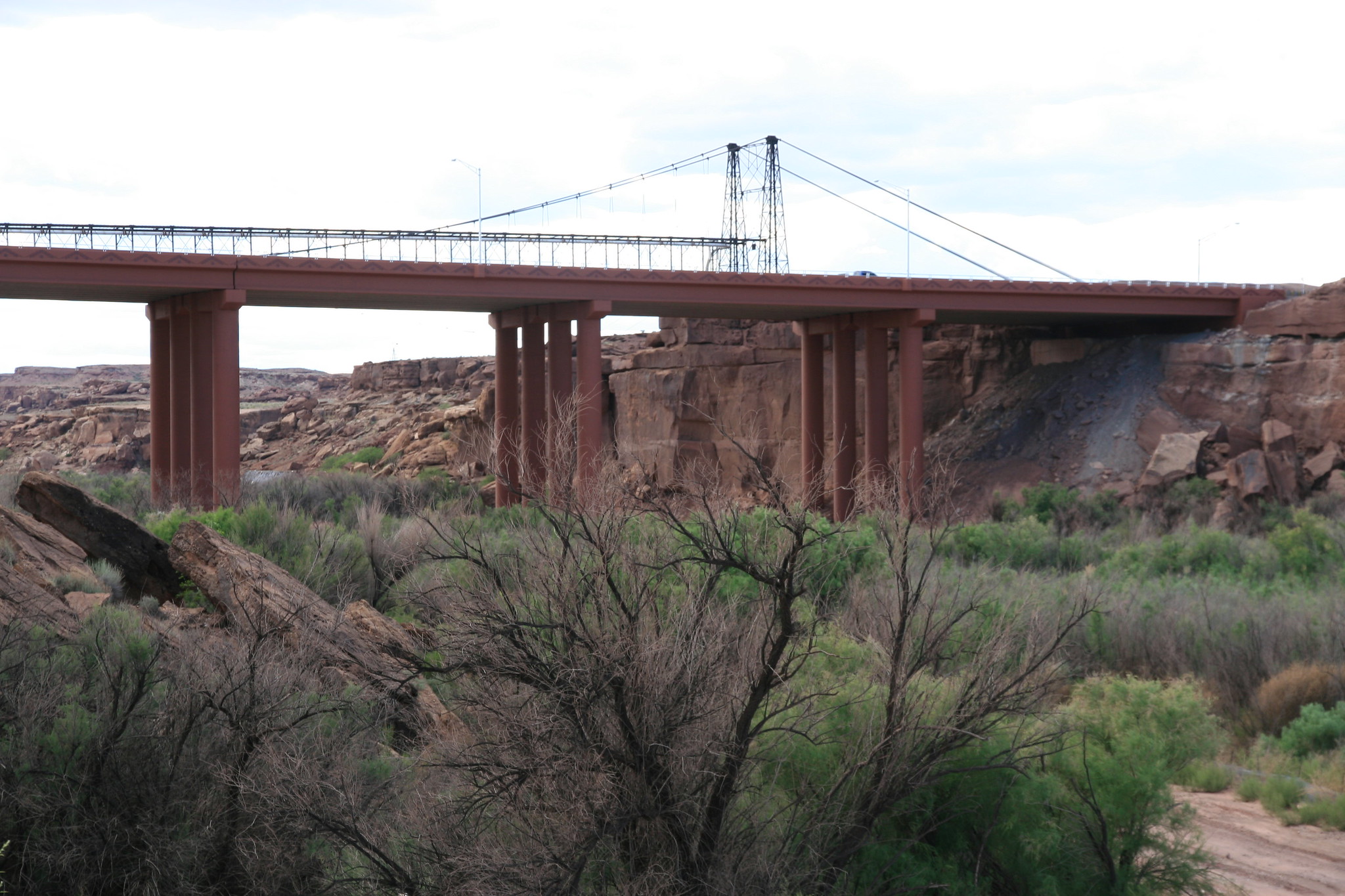Big bridge history near little Cameron
Big bridge history near little Cameron

Today three bridges cross the Little Colorado River near Cameron. The newest two spans for north- and- southbound traffic are flanked by the original 1911 crossing that today carries only an oil pipe.
As Arizona grew after becoming a state, so did the need for trappers, traders, and prospectors to cross the Little Colorado. Increasingly sophisticated bridges were constructed at the site in 1911, 1958 and 2016, which is where the Arizona Highway Department, and later ADOT, comes in.
But at the turn of the 20th century, there were no bridges.
“This was out in the middle of no-where,” said Merlin Carson, 78, an aero-space engineer turned Native American art expert who spends his days at the historic Cameron Trading Post. “There was nothing but sheep trails all over the place and a great many trading posts.”
The main way to cross the river at the edge of the Hopi and Navajo reservations was Tanner’s Crossing, named after Mormon prospector Seth Tanner from Tuba City. However, the rocky ford left much to be desired. Flooding and quicksand were unpredictable and dangerous.
BRIDGE PROJECT I
In March of 1911, Congress appropriated $90,000 for construction of a bridge built by the Midland Bridge Co. for the Office of Indian Affairs.
“At that time, there were hardly any cars,” Carson said. “It was a bridge for the Navajo people. The bridge was the earliest safe crossing of the river. It was meant for walking across with your cattle or your sheep.”
There's even a story that in 1937 a large herd of sheep crossing the bridge caused it to sway badly and nearly collapse, leading to some repairs to shore it up.
The Cameron Construction Bridge is an engineering marvel that played a large role in Arizona’s growth, according to an Arizona State Historic Preservation Office report.
According to the report, the bridge “is significant for its association with the initial growth of Arizona’s highway system as a major bridge which opened the northern portion of the state to development … A hybrid of suspension and truss forms, the bridge has engineering significance as the oldest surviving highway suspension bridge in the state and that utilized novel engineering techniques to cross the wide canyon of the Little Colorado River.”

Decades passed, technology advanced and foot traffic gave way to large vehicles. By the mid-1950s this became a problem as the old bridge was not capable of carrying heavy construction equipment needed to build the Glen Canyon Dam.
BRIDGE PROJECT II
It was a fight in Congress to get funding for the next bridge. The leading advocate was Arizona Sen. Carl Trumbull Hayden, who was elected in 1912 as the state’s first congressman and retired 56 years later after serving seven terms in the US Senate.
He wielded great power in his role as Senate Appropriations Committee chairman, and it was in this position that he argued eloquently and successfully for nearly $1 million in funding to build the Cameron Truss Bridge.
“I have in mind particularly construction of the bridge across the Little Colorado River in Arizona, absolutely essential in order to get material out to Glen Canyon Dam that is to be built,” Hayden said during hearings on Supplemental Appropriation Bill, 1958, according to a report in the Library of Congress.
“The present structure will not carry a heavy load, and the State of Arizona has obtained a very favorable contract for the bridge.”
To further accommodate construction equipment, US 89 was widened at that time and modernized from Flagstaff to Page.
In 1959, the Cameron Truss Bridge was completed over the Little Colorado just east of the original 1911 bridge. The truss bridge was useful for the next 57 years. That's just one year more than Hayden, its champion, served in Congress.

BRIDGE PROJECT III
In 2014, work began on an ambitious ADOT project that included tearing down the truss bridge and erecting a modern, wider crossing in its place. It was part of a $38 million, two-year project that also included expanding US 89 from two lanes to four and adding three miles of upgrades south of the bridge. New sidewalks, streetlights and four pedestrian and livestock underpasses were completed.
Before work on the new bridge could kick into gear, engineers faced the formidable challenge of removing the solid, heavy, steel truss bridge. Engineers solved it by first removing the deck, then cutting the remaining structure into six pieces, which were disassembled and hauled off site.
The modern replacement has two bridges, one each for northbound and southbound traffic. Each lane measures 12 feet.

When it was completed in 2016 it became the new neighbor of the old 1911 bridge. That first span doesn't carry traffic anymore, but utility lines over the Little Colorado River. While its usefulness as a traffic bridge has long ended, it continues serving Arizona faithfully.
It’s among the lures of travelers who frequent the historic Cameron Trading Post, where you might run into art expert Carson.
And the new bridge at Cameron? Like its forebearers, it will serve travelers for decades to come.

